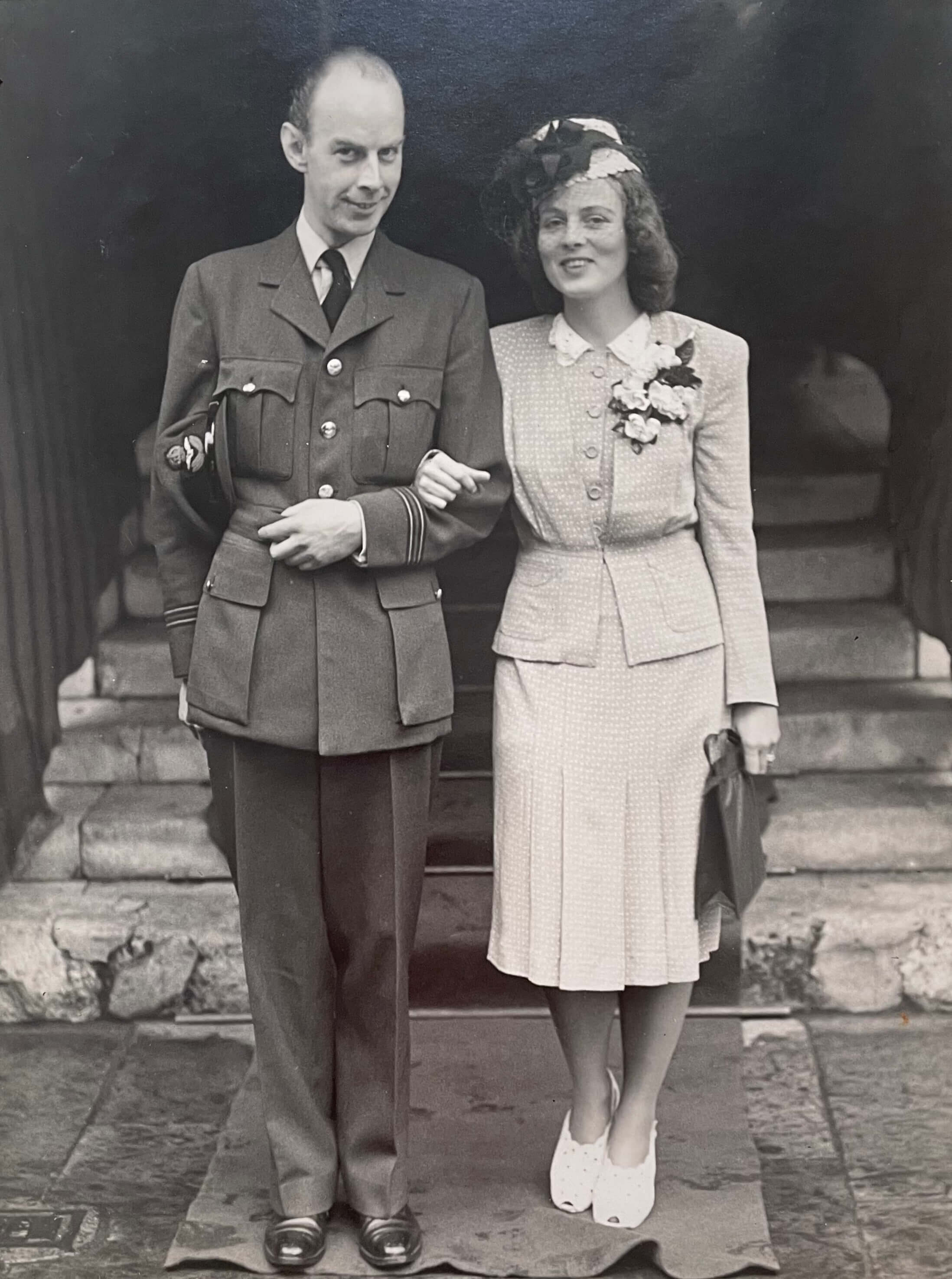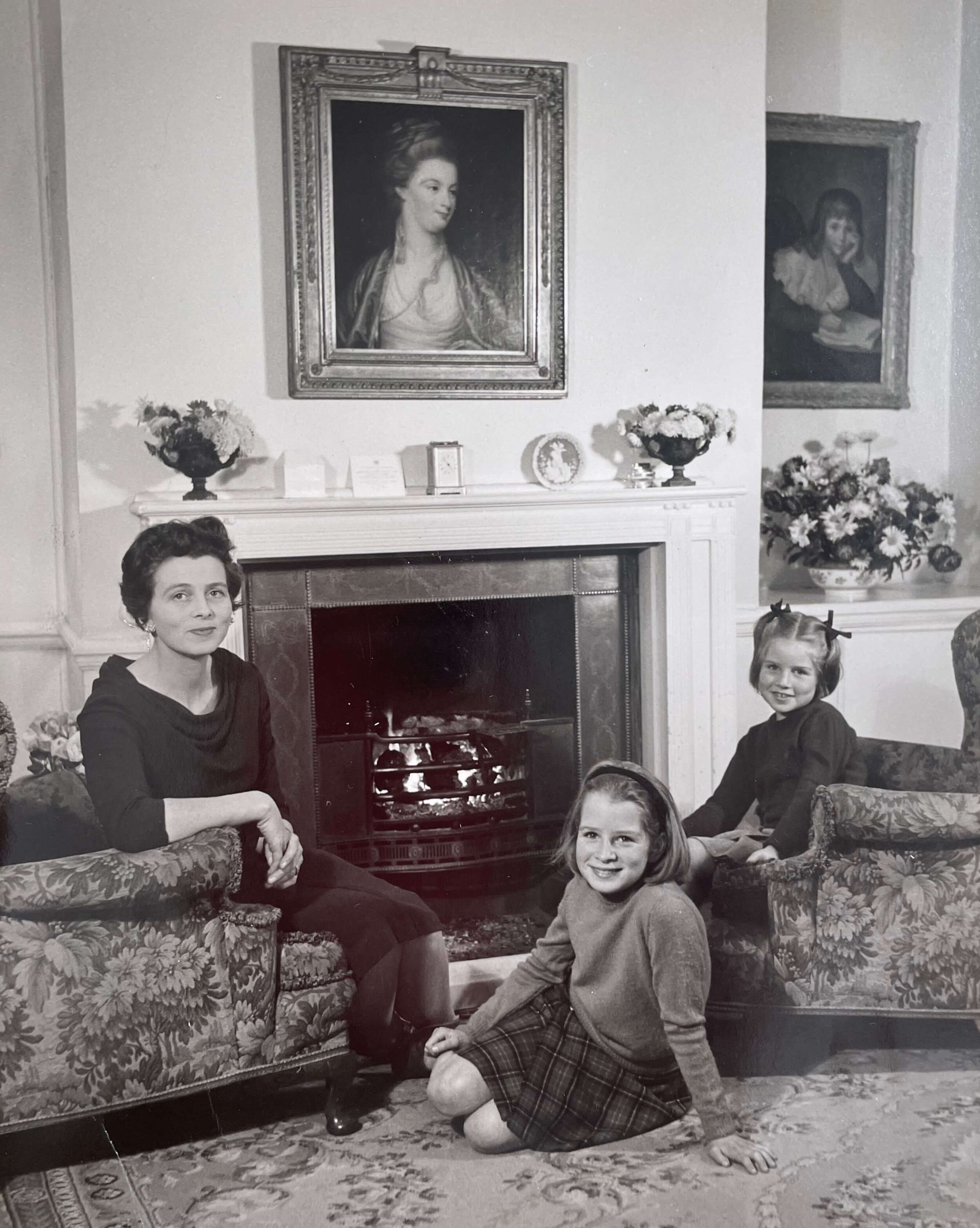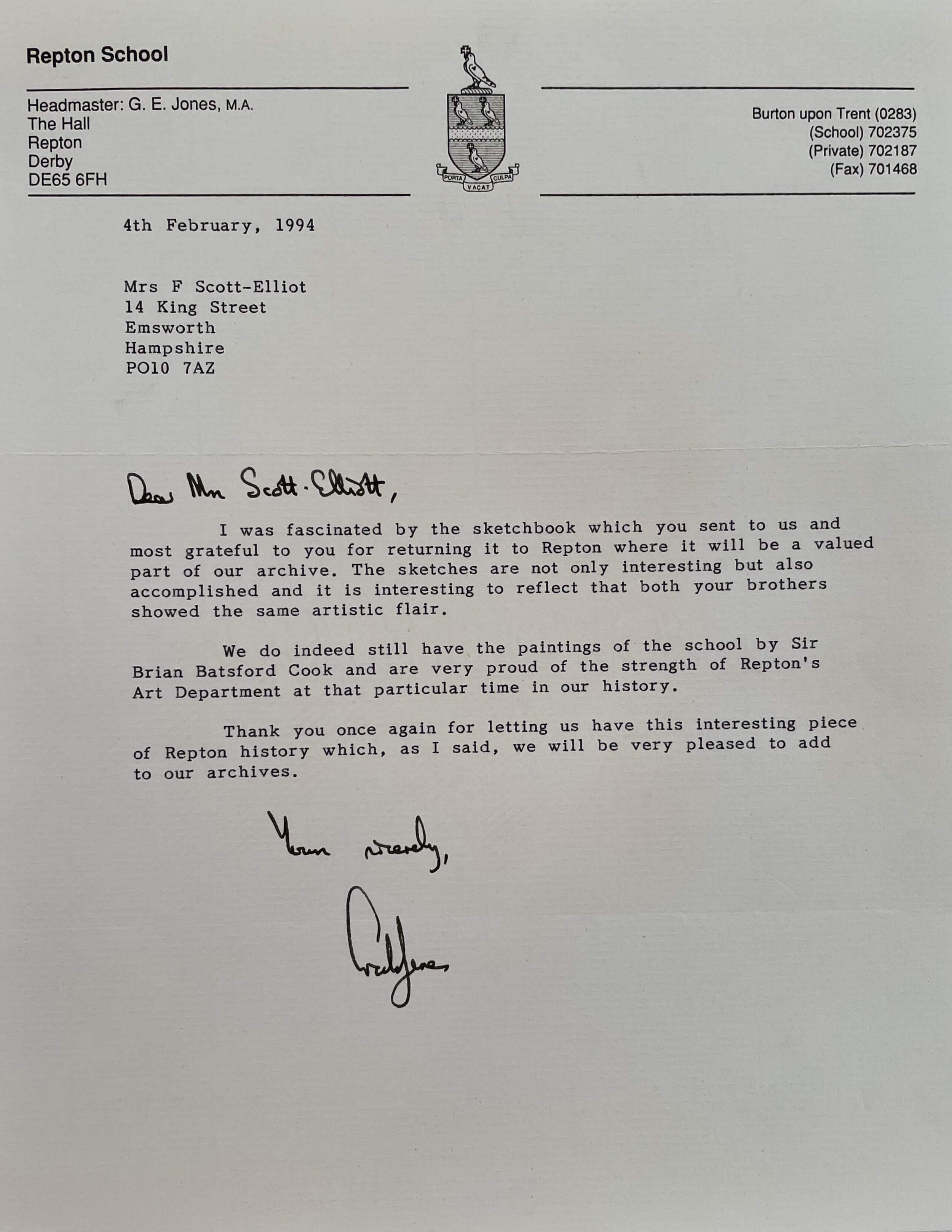
The River Trent at Repton, Derby, watercolour 1928
Early LIFE
Left to right: Brian Cook and his siblings Neil, Roger, and Fay
Brian Caldwell Cook was born on December 18, 1910 in Gerrards Cross, Buckinghamshire, England.
His parents were Dorothy Alice Batsford, sister of Harry Batsford, the publisher, and Arthur Caldwell Cook. Brian Cook had two brothers, Neil and Roger, and a sister, Fay.
Cook was educated at Repton School in Derbyshire, from 1924 to 1928, where he developed a talent for painting and, in particular, draughtmanship. He owed a considerable debt to Arthur Norris and Harold Gresley, (1892-1967) his tutors in art. Gresley came from a well-known family of landscape painters, and went to Repton as a visiting teacher. Arthur Norris provided the encouragement and facilities which produced a succession of recognized artists: Anthony Gross, Rupert Shephard, Anthony Devas, and Cook’s younger brother Neil, the most talented artist in the family according to Cook.
A drawing of his sister, Fay, by Neil Cook.
Neil went on to win a scholarship in his first year at the Slade, but was tragically killed while serving as a bomber pilot in 1941.
Cook and his sister, Fay, lost both brothers and their father within three years, Roger to tuberculosis at the age of 30.
The theory of perspective came naturally to the young Brian Cook. The coloured pen-and-ink drawing of the Art School at Repton (shown below), done at the age of 16, was completed in strips from top to bottom, without any conscious recognition of the rules of perspective – and no doubt, as Cook said, to the exasperation of his teachers. When Cook had the customary farewell interview with the headmaster Dr G.F. Fisher, subsequently Archbishop of Canterbury – he said, “Well, Cook, all I can say about you is that, if nothing else, you have at least learnt to paint.” It was true. Cook had never passed any exams and had often since regretted his laziness in any subject but drawing.
This interior drawing at Repton was followed a year later by a detailed study of the Sixth Form Room (now the Audit Room) (shown below in color). The original drawing still hangs in the room.
In 1928 Cook left Repton, attending the Central School of Arts and Crafts on a part-time basis.
It was agreed that Cook would go into the family bookselling and publishing business of Batsford, and attend art school in the afternoons.
The headmaster took one look at Cook’s work and said, “Now you must forget all this and start all over again.”
The difficulty of attending the Central only in the afternoons, arriving halfway through projects, made it impossible to continue, so Cook returned to full-time publishing.
Years later, Cook’s sister Fay, who was devoted to both her brothers, sent a sketchbook of theirs to Repton School. On February 4th 1994, she had the reply shown left.
“Gresley used to take me out to the field and water meadows and really taught me all I know.”
“I find it more difficult to trace the architectural element in so much of my work. From an early age I visited old Churches with my mother, and even for a time shared her love of the Tudor and Elizabethan periods, but much as I wanted to be an architect, I could not have the necessary training and I can only attribute my interest to the countless books on architectural subjects published by the family firm of Batsford which must have been lying about at home.””
“It was inevitable, as the time came for me to leave school, that I should urge my parents to allow me to take up art as a career. There was never any question of their being able to afford this but they did take me round to various well-known artists of the day, mostly Academicians, to ask for their opinion, which was not very conclusive”
B.T.BatsforD Ltd.
Harry Batsford, Brian Cook’s uncle and the owner of B.T.Batsford Publishing
In 1928 Cook went to work for his eccentric Uncle, Harry Batsford, head of the eponymous publishing firm, where his arrival was greeted by the 1929 financial slump. The firm’s reaction to the crisis was dramatic – not only were staff reduced, but Uncle Harry decided to dispense with the services even of authors and illustrators.
Charles Fry, Manager and Chief Editor, penned many of the early volumes, along with publisher, Harry Batsford.
For a short time he and his chief editor Charles Fry (who joined the firm in 1924 as Harry Batsford’s personal assistant, and soon became a director) researched and wrote all the books themselves, while to Batsford’s newly-arrived nephew fell the job of helping with picture research, providing text drawings and, in particular, designing and illustrating the jackets.
It was here that Cook learnt the intricacies of the various processes of reproduction: letterpress, photogravure, lithography and even collotype; and the names and sizes of typefaces, the weight and texture of paper.
“Although organized in these squalid and cramped conditions, the firm’s products maintained a high standard and I remember with pride the work first entrusted to me: the division into two volumes of The Domestic Architecture of the Tudor Period by Garner and Stratton. The two folio volumes had a deep-red wrapper to match the buckram binding on which, in addition to their title and author’s names, was embossed a Tudor medallion designed by Kruger Gray, then designer of a new set of coins of the realm.”
“My first few years at Batsfords were spent in an eighteenth-century building in Holborn which was reputedly held up only by the shelves of books in every room. There was one small window overlooking the chimney pots of Red Lion Square. Everybody in the room smoked.”
Colophon 1930, symbolizing the succession of booksellers in High Holborn since 1611.
The tasks of designing and illustrating the jackets gave Brian Cook the creative opportunity to prove himself in a way that won him a permanent and properly credited place in the history of twentieth-century art and design. The books were adorned with an entirely new form of coloured wrap-around-jacket. The limitations of the printing process, which allowed only the use of brilliant primary colours, helped to give the Batsford jackets their distinction.
The Villages of England was the first jacket designed by Brian Cook, and the first to be reproduced using the Jean Berté process.
A poster created for the Travel Association of Great Britain and Northern Ireland to promote Britain as a holiday destination
Much of Cook’s inspiration came from his many jaunts deep into the British Countryside in his Uncle Harry’s beloved Morris.
The firm’s principal publishing field at that time was typography; full colour jackets were almost unknown. The bright, poster-style designs that Brian Cook created became the hallmark of the British Heritage Series. Over the next 10 years he produced jacket illustrations for over 100 titles which have since become collectors’ items. Besides designing more than 200 book jackets and contributing numerous pen-and-ink illustrations to Batsford publications, he exhibited in Paris and designed posters for Thomas Cook, The London & North Eastern Railway and The British Travel and Holidays Association, that came to typify the style of the period.
During his nigh-on 50 year association with the eponymous family publishing house, the name of Batsford became synonymous with well-produced books on “heritage” subjects.
The Heart of Scotland, from The British Heritage Series
The multi-volumed Batsford British Heritage series of the 1930’s is credited with opening readers’ eyes to the beauty and variety of the British Isles. In their time these books were pioneers with comprehensive coverage of British heritage in its truest sense; from cathedrals, churches and country houses to towns, villages, farming, hunting and other rural traditions.
Batsfords clung to the tradition of good craftmanship; the pleasure of opening a book which has been sewn by hand and printed by a craftsman who appreciates the proportions of a well-set title page and the relation between a page of print and its margin.
MILITARY LIFE
During the 1939-45 War Cook served with the RAF in Bomber Command Intelligence. Later, Cook, at the request of his uncle, changed his name by deed poll to Batsford in 1946 with a view to taking over the chairmanship of the family firm, which he did in 1952. This event caused the artist to be lost from view, and also coincided with the development of his career as a politician.
personal life


Brian Cook Batsford married Joan Cunliffe in 1945. They had two daughters, Georgina and Sophia, the latter an established artist under her married name Sophia Tise.
He was an inveterate house mover, and with his wife, also known as Wendy, a fine artist in her own right, he shared at least a dozen homes over the years, including their home in North Cornwall, a county for which he had a lifelong affection and where much of his landscape painting was executed. He produced many canvases there that delighted, among others, his old friend and neighbour, the late Sir John Betjeman, whose Cornish poems Batsford illustrated.
He restored houses to their originality with great enthusiasm, and created gardens with an emphasis on design rather than horticulture.
Batsford’s kind and gregarious nature earned him many friendships throughout his life, but perhaps none more important than his lifelong association with Cecil Beaton.
Political Life
Having left the name Brian Cook behind, Brian Batsford as he was now known, moved into politics while continuing to chair the family firm.
“Father, Brian Batsford, Ealing South’s Conservative candidate, was so busy electioneering at a meeting, his daughter, Sophia, decided to celebrate her ninth birthday with him. She is seen cutting the cake, watched by sister Georgina, father and mother - Mrs. Wendy Batsford.” - from an old family news clipping.
As a politician Batsford maintained a relatively low profile in the House – seldom speaking in the Chamber but working loyally behind the scenes, principally in the Whips Office where he became Deputy Chief Whip in Opposition from 1964 to 1967.
In April 1967, after the Conservatives had gained control of the Greater London Council, Edward Heath appointed Batsford as his GLC liaison officer, to ensure co-ordination of Conservative Party policy in London affairs. As an Alderman, he held the post until 1970.
As a Whip Batsford was noted for the quiet persuasiveness of his methods. Throughout his political life, his painting skills never left him, and in 1962 he designed the House of Commons Christmas card depicting a winter scene in Parliament square. The card proved enormously popular and sold many copies. (Batsford also designed a personal annual Christmas card throughout his lifetime - something friends and family members looked forward to receiving each year. While rarely on public view, these mementos of his talent for turning the ordinary into the extraordinary are highly prized. Examples from the family’s collection can be seen here.)
His first foray into politics was to fight the Chelmsford “khaki“ by-election for the Tories in 1945. It was an unmitigated disaster. Characteristically, Batsford described his loss as “an amazing experience. I turned a Tory majority of 14,000 into a Labour majority of 6,000.”
It wasn’t until 13 years later, at a second attempt, that he succeeded in winning a parliamentary seat.
He served as that constituency’s MP until 1974 when he was knighted in Edward Heath’s dissolution honors. The award is a fitting tribute to the borough’s longest serving parliamentary representative.
In a distinguished career, Batsford was the Parliamentary Private Secretary to the Minister of Works from 1959-60.
In 1974 Batsford was knighted in Edward Heath’s dissolution honors.
Following his retirement from politics, Batsford served as Chairman of the Royal Society of Arts.
1962 House of Commons Christmas Card designed by Brian Cook Batsford.
“Mind you, when I was adopted as a political candidate for Ealing South in 1958 as Batsford, nobody knew I was the Brian Cook who had lost at Chelmsford!”
In November 1970 Batsford announced he would not seek re-election as an M.P. when his Ealing South constituency was to be swallowed up under the boundaries reorganization. He retired from both publishing and politics, standing down as Chairman of Batsford, but remaining president until 1977. He was on the Post Office’s Stamp Advisory Committee until 1980, and also Chairman of the Royal Society of Arts.
LATER LIFE
Batsford’s illustration of Lamb House for one of his annual Christmas Cards.
Batsford’s re-discovery as the artist Brian Cook happened quite by chance at the age of 75 and led to an all too brief Indian summer of recognition and acclaim. Contemporary artists such as Allen Jones, Ian Beck and Glynn Boyd-Harte had long been avid collectors of Cook’s work unaware, at the time, that he was in fact still alive and well, and living under his other name of Batsford.
Sir Brian and his wife were tenants for many years of Lamb House in Rye, home of the American novelist Henry James. There, he worked tirelessly to produce yet another attractive garden for the many visitors to enjoy. His tall Panama-hatted figure was always a reassuringly familiar sight in the cobbled streets of Rye where he was president of the Rye Conservation society from 1983 – 1991.
Batsford at home at Lamb House. Photographer: Guglielmo Galvin
When questioned about his identity being revealed, Sir Brian recalled the exact moment the modern design world tracked him down. Its herald was an intrepid arts council exhibition organizer, who, he said, “just came knocking at my door one day. He had one of my tatty old book jackets in his hand, asking if I had any idea of the whereabouts of somebody called Brian Cook. I did find it rather amusing.”
Harrods biscuit tins which Cook was involved in designing although he says he found the additional lavender trimming “rather too nitsy-natsy for my taste.”
He received new commissions. His work was included in the exhibition Landscape Britain 1850-1950 at the Hayward Gallery in London in 1983. Advertising illustrators emulated his style; collectors acquired his original artwork and books. He gained commissions from organizations such as Harrods, through Ian Logan, the designer; and The National Trust; ranging from Christmas catalogues to biscuit tins. He was the subject of numerous articles and television programmes.
The artist viewed all this attention with modesty and amusement:
“I am the artist who came in from the cold” he said.
In 1986 Batsford’s published The Britain of Brian Cook (followed by Brian Cook’s Landscapes of Britain, published posthumously in 2010), which demonstrated how precisely attuned he was, to the illustrator’s art.
Sir Hugh Casson called it “Cook’s tour de force” and certainly this look back over 50 years combined with a very successful retrospective exhibition at The Michael Parkin Gallery in Knightsbridge London, gave Sir Brian every reason to enjoy the twilight of a fame that had been his as the young Brian Cook.
Oil painting of Batsford’s life, by his sister Fay.
His health deteriorated seriously in 1989, but at his last home in Winchelsea, he managed, yet again, to create a charming small garden completely from scratch. It was here, written in the words of his son-in-law, Simon Master, that “despite the severity of his final illness, he was able to die peacefully, looking through the artist’s favoured north light, at distant Rye across an unspoilt landscape that his life and work had done so much to celebrate.”
Perhaps the best way of summing up Brian Cook Batsford’s life is to quote the observation of Walter Sickert:
“The artist paints not what he sees but what he is”, and this is how his family believed he would wish to be remembered.
Died 5 March 1991








